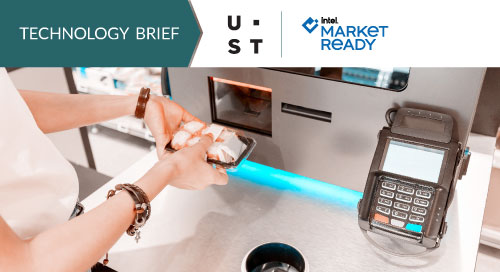Frictionless Checkout: The Future of Retail Technology

Anyone who has ever braved a grab-and-go counter, fast-food, or quick-service location at the airport understands the anxiety that comes with long lines—especially when you face a time crunch.
Do you wait and risk missing your flight? Or do you rush to your gate and resign yourself to nibbling on peanuts and pretzels for your entire three-hour flight?
UST Global, a leading digital transformation solutions company, is working to solve this dilemma for consumers. Its next-generation retail technology, UST Vision Checkout, uses machine learning and artificial intelligence (AI) at the edge to innovate touchless checkout for plated and non-barcoded items in airports, corporate cafeterias, and other food service locations. The solution automates and accelerates the checkout experience, removing friction for customers and boosting operational and cost efficiencies for food service providers.
Challenges at Checkout
Customers spend an inordinate amount of time in the checkout line and at retail kiosks, but companies historically haven’t focused on improving this experience. But rising consumer expectations now compel companies to innovate and focus on the total shopping experience, according to Subhodip Bandyopadhyay, Global Head of Frictionless Commerce at UST Global.
“This whole thought process of giving more value to the customer by saving their time and giving them an outstanding checkout experience is a key driver behind frictionless commerce,” he says.
The Great Resignation also is fueling innovation. Food service operators face labor shortages and rising labor costs that have increased the need for AI-driven automation to augment staffing resources. Bandyopadhyay says retailers must retrain their workforce to adapt to new customer fulfillment processes without reducing their margins, so they’re looking for more ways to streamline and digitize the process and give customers more control over the checkout experience.
Vision Checkout can deliver all these capabilities for food service operators.
“What #AI brings is a new way of delivering the user experience. The #shopping experience is completely changed from a customer’s point of view.” — Paul Reddy @USTglobal via @insightdottech
Transforming the Checkout Experience
UST Global solution uses AI at the edge, machine learning, and computer vision to make checkout frictionless. Unlike traditional touchless checkout systems, Vision Checkout scans non-plated items and items without barcodes.
“What AI brings is a new way of delivering the user experience. Computer vision can see multiple items at a time, and with this new technology you can identify items using Vision AI in less than a second. The shopping experience is completely changed from a customer’s point of view,” says Paul Reddy, Head of Vision AI Product Development at UST Global.
Reddy says the company has developed a solution called Product Box, which allows it to collect images from thousands of product SKUs for a particular food service location or retail kiosk. The company then uploads this information into a database to train its AI models, which it then deploys to locations that have Vision Checkout. Vision Checkout also uses the Intel® OpenVINO™ Toolkit and Intel® Smart Edge platform to process massive amounts of data, providing the low latency and processing power necessary to speed the checkout experience and ensure items are tabulated accurately.
With Vision Checkout, there’s no serial scanning since all the product data for each item is already in the system. Customers can check out and purchase multiple items at once—like a sandwich, soda, banana, and granola bar—without searching for a barcode to scan and subsequently holding up the line.
Bandyopadhyay says computer vision also helps food service operators reduce fraud.
“In a self-checkout counter where vision is not deployed, there is a possibility of creating fraud,” he says. “The moment it is computer vision, it’s like the human eye—you see a chicken sandwich as it gets scanned, so the possibility of gaming the system is reduced to a bare minimum.”
Bringing Retail into the Future
In addition to airports and corporate cafeterias, Vision Checkout can be deployed at sports arenas and midsize grocers.
For example, UST Global has worked with Nourish + Bloom Market to deploy a range of digital transformation solutions and create the first African American-owned autonomous grocery store in the country. So far, Nourish + Bloom has installed two Vision Checkout devices. The grocer uses the solution for a large merchandise assortment outside its autonomous store and to facilitate checkout for products such as age-restricted items, fruits and vegetables, and frozen foods. Nourish + Bloom plans to launch more than 500 stores in the U.S. using Vision Checkout and UST Global’s other digital solutions.
Bandyopadhyay says UST Global plans to enhance Vision Checkout in several ways. Soon, Vision Checkout will include an enterprise-scale image repository, voice recognition, and hover detection capabilities. Currently, the company’s AI model can ingest data for 10,000 items, but as AI advances, UST Global hopes to have the capability to ingest tens of thousands of SKUs, so it can serve large grocers and other enterprise food service operators.
Bandyopadhyay says all these efforts are part of the UST Global vision to create a more connected retail ecosystem, one where every device can talk to every other device and deliver human-centric machine learning experiences.
“In simple terms, what does it mean? That every single device, if they work in harmony with each other, can give the customer—any customer, retail or enterprise—a very different kind of experience,” he says. “That’s the dream. That’s our vision.”
This article was edited by Georganne Benesch, Associate Editorial Director for insight.tech.